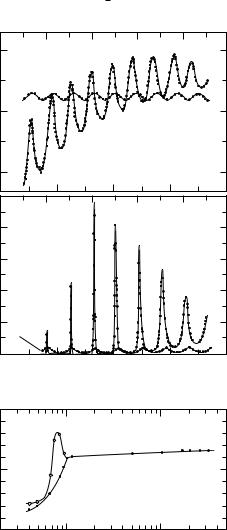
Dressel.Gruner.Electrodynamics of Solids.2003
.pdf



422 |
|
|
|
|
Appendix C k · p perturbation theory |
|
|
|
|
|
|
|
||||||||||||||||
indicates that we consider a unit cell (Eq. (4.3.12)). Thus |
|
|
|
|
|
|
|
|||||||||||||||||||||
|
|
|
|
|
|
|
|
|
|
|
h |
|
|
|
|
kl |
|
kl |
|
|
|
kl |
q |
|
p |
kl |
|
|
kl |
k |
+ |
q, l |
|
= |
kl |
kl |
|
¯ |
l |
|
| |
|
|
|
| |
|
· |
| |
|
|
|
||||||
|
|
|
|
|
|
|
||||||||||||||||||||||
|
|
|
|
Ekl − Ekl |
|
|
|
|||||||||||||||||||||
| |
|
|
|
| |
|
+ m |
|
|
|
kl |
|
|
|
|
||||||||||||||
|
|
|
|
|
|
|
|
|
h |
|
kl |
q |
|
|
p |
|
|
|
|
|
|
|
|
|
|
|||
|
|
|
|
|
|
δll |
|
|
¯ |
|
| |
|
· |
| |
|
|
|
|
, |
|
|
|
|
|
(C.4) |
|||
|
|
|
|
|
= |
|
|
l |
Ekl − Ekl |
|
|
|
|
|
|
|||||||||||||
|
|
|
|
|
|
|
+ m |
|
|
|
|
|
|
|
|
|
|
|||||||||||
since kl|kl = 0 for l = l |
because the periodic part is orthogonal ukl ukl = |
|||||||||||||||||||||||||||
δll . By defining the momentum operator Pll in the direction of q and the energy |
|||||||||||||||||||||
difference hωl l as |
|
|
|
|
|
|
|
|
|
|
|
|
|
|
|
|
|
|
|
|
|
¯ |
|
|
|
|
= −1 |
|
|
|
|
|
|
|
|
|
|
|
|||||
|
|
|
Pll |
dr ukl p ukl |
|
|
|
|
|
||||||||||||
|
|
¯ |
|
|
= |
E |
kl |
− E |
|
|
|
|
|
|
|
|
|
||||
|
|
hωl l |
|
|
|
|
kl |
|
|
|
|
|
|
|
|
|
|||||
with the volume of the unit cell, we obtain |
|
|
|
|
|
|
|
|
|
||||||||||||
|
| |
k |
+ |
q, l |
= |
δll |
+ |
|
hq |
l |
Pll |
. |
|
|
|
(C.5) |
|||||
|
m |
h¯ ωl l |
|
|
|
|
|||||||||||||||
|
kl |
|
|
|
|
¯ |
|
|
|
|
|
|
|
||||||||
Since the summation is reduced to the exclusion of the term l |
= |
l , we finally |
|||||||||||||||||||
obtain for the expression in Eq. (4.3.20) |
|
|
|
|
|
|
|
|
|
|
|
||||||||||
|
|
|
|
|
|
|
|
|
|
|
|
||||||||||
|
|
|
|
|
|
|
|
|
|
|
|
δll ) |
q |
|
2 |
|
|
|
|||
| k + q, l | exp{iq · r}|kl |2 = δll + (1 − |
| Pl l |2 , |
(C.6) |
|||||||||||||||||||
|
|||||||||||||||||||||
mωl l |
|||||||||||||||||||||
which is equal to unity for l = l , but has to be taken into account in the case of interband transitions.
Reference
[Sei40] F. Seitz, The Modern Theory of Solids (McGraw-Hill, New York, 1940)
Further reading
[Jon73] W. Jones and N.H. March, Theoretical Solid State Physics (John Wiley and Sons, New York, 1973)
[Mer70] E. Merzbacher, Quantum Mechanics, 2nd edition (John Wiley & Sons, New York, 1970)
[Woo72] F. Wooten, Optical Properties of Solids (Academic Press, San Diego, CA, 1972)

424 |
Appendix D Sum rules |
but we can equally well use the momentum matrix element
pl0 = l (ih¯ ) 0 dr ,
and in this form fl0 becomes
fl0 |
|
2 |pl0 |
|2 |
. |
(D.2) |
|
= mhω |
|
|||||
l0 |
||||||
|
¯ |
|
||||
The oscillator strength fl0 measures the relative probability of a quantum mechanical transition between two atomic levels. The transition obeys the so-called Thomas–Reiche–Kuhn sum rule
fl0 = 1 , |
(D.3) |
l
which can be proven by considering some general commutation rules.
The absorbed power per unit time can also be calculated in a straightforward manner, and one finds that
P = |
π e2 E02 |
|rl0|2 ωl0 |
, |
(D.4) |
|
h |
|
||
|
|
¯ |
|
|
which can be cast into the form of
|
2mhω |
0 |
rl0 |
|
2 π e2 E2 |
π e2 E2 |
|
|
||||
P = |
¯ h¯l |
|
| |
| |
|
|
0 |
= |
0 |
l |
fl0 . |
(D.5) |
2 |
|
2m |
2m |
|||||||||
The expression in front of the sum is just the power absorption by a classical oscillator, which itself must be equal to P, and thus #l fl0 = 1 as stated above. If these are a collection of atoms, as in a solid, which might also have more than a single electron, the sum rule is modified to become [Ste63]
fl0 = N , |
(D.6) |
l
where N is the number of electrons per unit volume. Note that the sum rule does not contain information, and thus is independent of the wavefunctions and energies of the individual energy levels. Of course the oscillator strength associated with the transitions is sensitive to these; however, the sum of the oscillator strengths must be fixed, and must be independent from the details of the system in question.
D.2 Conductivity sum rules
Here the absorbed power has been expressed in terms of the oscillator strength associated with the various transitions between the energy levels of the atoms, but the sum rule can also be expressed in terms of the optical conductivity σ1(ω). In

D.3 Sum rule from Kramers–Kronig relations |
425 |
order to see this, let us calculate the rate of energy absorption per unit time for a time-varying field as given before. This rate is given by Eq. (3.2.34) as
d |
|
∂D |
|
|
∂E |
|
|
E2 |
σ1 E2 |
|||
E |
= Re |
|
|
· E |
= Re ( 1 + i 2) |
|
· E |
= ω 2 |
0 |
= |
0 |
. (D.7) |
dt |
∂t |
∂t |
2 |
8π |
||||||||
The total absorption per unit time is
P = |
E02 |
2 |
|
|
|
|
ω 2(ω) dω = E0 |
σ1(ω) dω , |
(D.8) |
||
4π |
which, in view of our previous expression of the absorbed power, becomes
|
|
π N e2 |
ω2 |
|
|
|
σ1(ω) dω = |
|
= |
p |
, |
(D.9) |
|
2m |
8 |
|||||
with ωp = 4π N e2/m 1/2 the so-called plasma frequency. It is clear how valuable such a sum rule argument is: while the frequency dependence of the conductivity can be influenced by many features, including band structure and interaction effects, the sum rule is independent of these and must be obeyed.
D.3 Sum rule from Kramers–Kronig relations
The same relation can be derived by utilizing the Kramers–Kronig relations, and from some general arguments about the conductivity or dielectric constant. In order to do this, first note that the complex dielectric function has, at high frequencies, the following limiting form:
ω2
1(ω) = 1 − p , (D.10)
ω2
already derived in Eq. (3.2.25). This in general follows from the fact that inertial effects dominate the response at high frequencies. Next let us look at the Kramers– Kronig relation (3.2.12a)
1(ω) − 1 = |
2 |
P |
0 |
∞ ω 2(ω ) |
dω . |
|
π |
|
ω 2 − ω2 |
||||
This, in the high frequency limit – at the frequency above which there is no loss, and consequently 2(ω) = 0 – then reads
1 |
(ω) − 1 ≈ − π ω2 |
0 |
∞ ω 2(ω ) dω . |
|
2 |
|
|
Equating this with expression (D.10), we find that
∞ |
|
π |
|
|
0 |
ω 2(ω) dω = |
|
ωp2 , |
(D.11) |
2 |

426 |
|
Appendix D Sum rules |
|
||||
or alternatively |
|
|
|
|
|
|
|
0 |
∞ |
|
π N e2 |
|
ω2 |
|
|
σ1(ω) dω = |
|
= |
p |
, |
(D.12) |
||
|
2m |
8 |
|||||
the same as found in Eq. (D.9).
D.4 Sum rules in a crystal
The sum rule given above holds for a collection of atoms in a solid; and in a crystal it can be directly related to the electron structure in certain limits. Using Bloch wavefunctions with the periodic part ukl as defined in Eq. (4.3.5) to describe the electronic states in a crystal, the Schrodinger¨ equation reads Hkukl = Ekl ukl , where the Hamilton operator is given by
|
|
= H |
|
+ H + H = |
p2 |
|
|
h |
k |
|
p |
|
h2k2 |
|
(D.13) |
|
H |
k |
0 |
|
+ |
+ |
|
· |
+ |
|
. |
||||||
2m |
m |
2m |
||||||||||||||
|
|
1 2 |
|
|
V (r) |
¯ |
|
|
¯ |
|||||||
V (r) denotes the periodic potential. The term in the squared brackets describes the energy levels at k = 0. H1 is a first order perturbation and H2 is a second order perturbation. With the zero order expressions ukl = u0l and Ekl = E0l , we obtain for the first order terms
kl |
0l |
|
h |
k |
|
0l |
p |
0l |
|
, |
¯ |
|
|
||||||||
E |
= E |
+ |
m |
|
· |
| |
| |
|
|
|
where the correction to the energy cancels for crystals with inversion symmetry. Therefore, the second order correction to the energy also becomes important, and
kl 0l |
h2k2 |
|
h2 |
|
| |
k |
· |
0l |
p |
0l |
| |
2 |
|
(D.14) |
¯ |
¯ |
|
|
| |
| |
|
, |
|||||||
E = E + |
2m |
+ |
m2 |
l l |
|
|
E0l − E0l |
|
|
|
||||
|
|
|
|
= |
|
|
|
|
|
|
|
|
|
|
where the labels l and l refer to different electron states in the crystal.
A Taylor series expansion for the energy of an electron in the neighborhood of
k = 0 gives: |
|
|
|
|
|
|
|
|
|
|
|
|
|
|
|
|
|
|
|
|
|
|
||
E |
= E |
0l |
+ |
|
∂E0l |
k |
|
+ |
1 |
|
∂2E0l |
k k |
= E |
+ |
|
∂E0l |
k |
|
+ |
h2 |
k k |
|
, (D.15) |
|
|
|
|
|
|
|
2mi j |
|
|||||||||||||||||
|
∂ki |
i |
2 ∂ki |
∂k j |
|
∂ki |
i |
i |
j |
|
||||||||||||||
kl |
|
|
|
|
|
|
|
|
|
|
i j |
0l |
|
|
|
|
|
¯ |
|
|||||
where we have substituted the effective mass tensor mi j defined in analogy to Eq. (12.1.17):
1 |
|
|
1 ∂2 |
(k) |
||||
|
|
i j |
= |
|
|
E |
. |
|
m |
h2 |
∂ki ∂k j |
||||||
|
|
|
¯ |
|
|
|
|
|

D.5 Electron gas with scattering |
427 |
We can now compare the third term of this expansion with the corresponding term of Eq. (D.14) obtained by second order perturbation, and we find that
m |
δ |
2 |
|
0l| pi |0l 0l | p j |0l . |
(D.16) |
|||
m |
= i j + |
m |
l =l |
E |
− E |
0l |
|
|
i j |
|
|
|
0l |
|
|
||
With the expression of the oscillator strength in terms of the momentum matrix element, given by Eq. (D.2), where again h¯ ωl l = El − El , we immediately obtain for a cubic crystal
m |
|
|
|
m = 1 − l=l |
fl l . |
(D.17) |
|
Thus the bandmass is related to the interband transition. For free electrons m = m, and thus # fll = 0; there is no absorption by a free-electron gas. This is not surprising, as – in the absence of collisions which absorb momentum – the different electronic states correspond to different momenta, and thus the electromagnetic radiation for q = 0 cannot induce transitions between these states. This also follows from the Drude model, in the collisionless, τ → ∞ limit, for which
N e2
σˆ (ω) = i mω
and there is no dissipation at any finite frequency. For τ finite, however, momentum and energy are absorbed during collisions, and these processes lead to the absorption of electromagnetic radiation at finite frequencies, consequently the sum rule is restored, and
|
σ1Drude(ω) dω = |
π N e2 |
, |
2m |
as can be verified by direct integration of the simple Drude expression (5.1.8).
D.5 Electron gas with scattering
Of course, the Drude model, with a frequency independent relaxation rate and mass, is a crude approximation, and even in the absence of a lattice electron– electron and electron–phonon interactions result in frequency dependences of these parameters. In the absence of interband transitions, the sum rule for the conduction band must be conserved – i.e. the plasma frequency is independent of the interactions. This then sets conditions for 1/τ (ω) and m(ω), and it is expected that the proper Kramers–Kronig relations with 1/τ (ω) and m(ω) will leave the total spectral weight associated with σ1(ω) unchanged.
This also holds when these interactions lead to broken symmetry ground states, such as superconductivity or density waves: for these states the sum rule including
